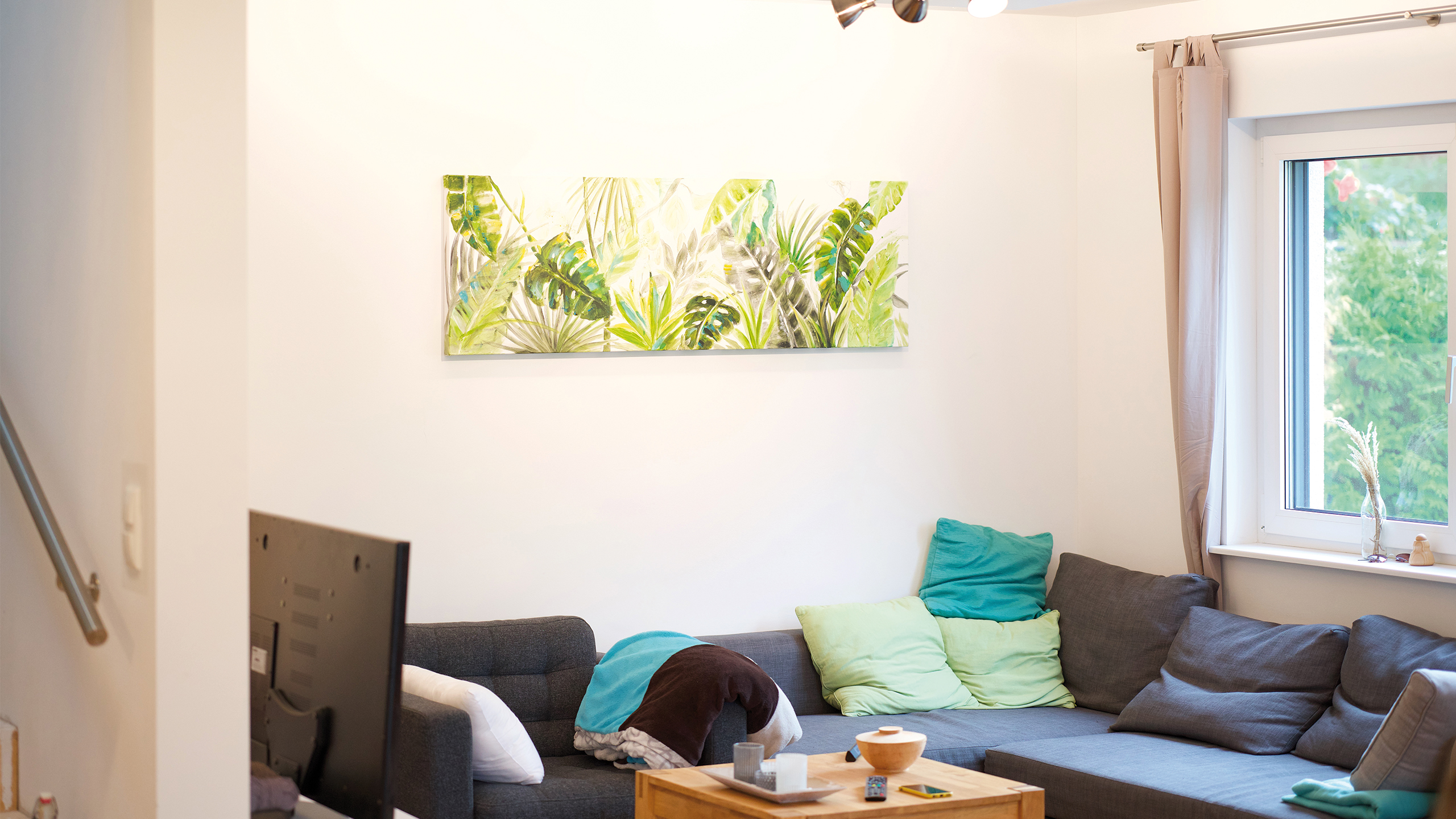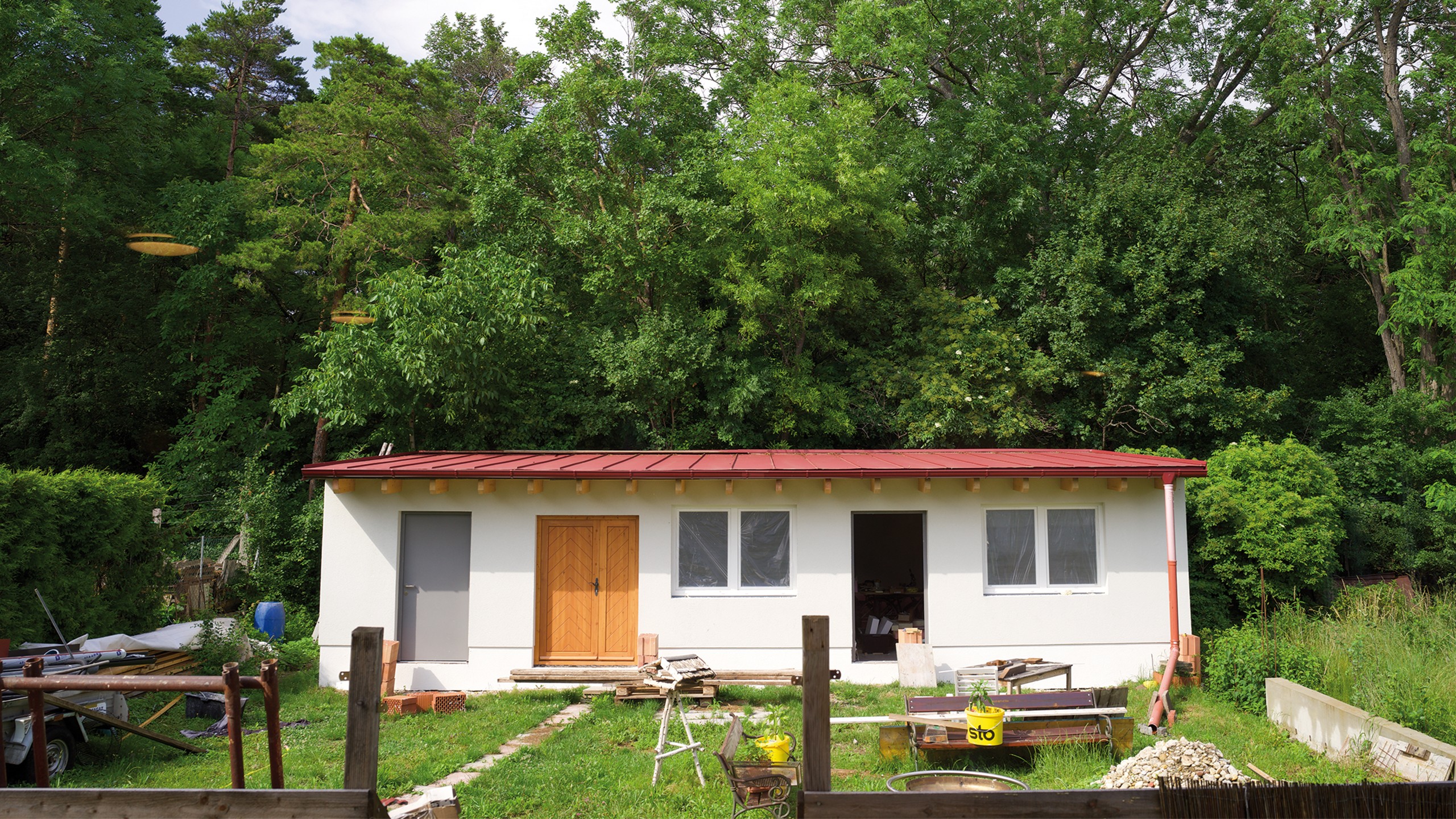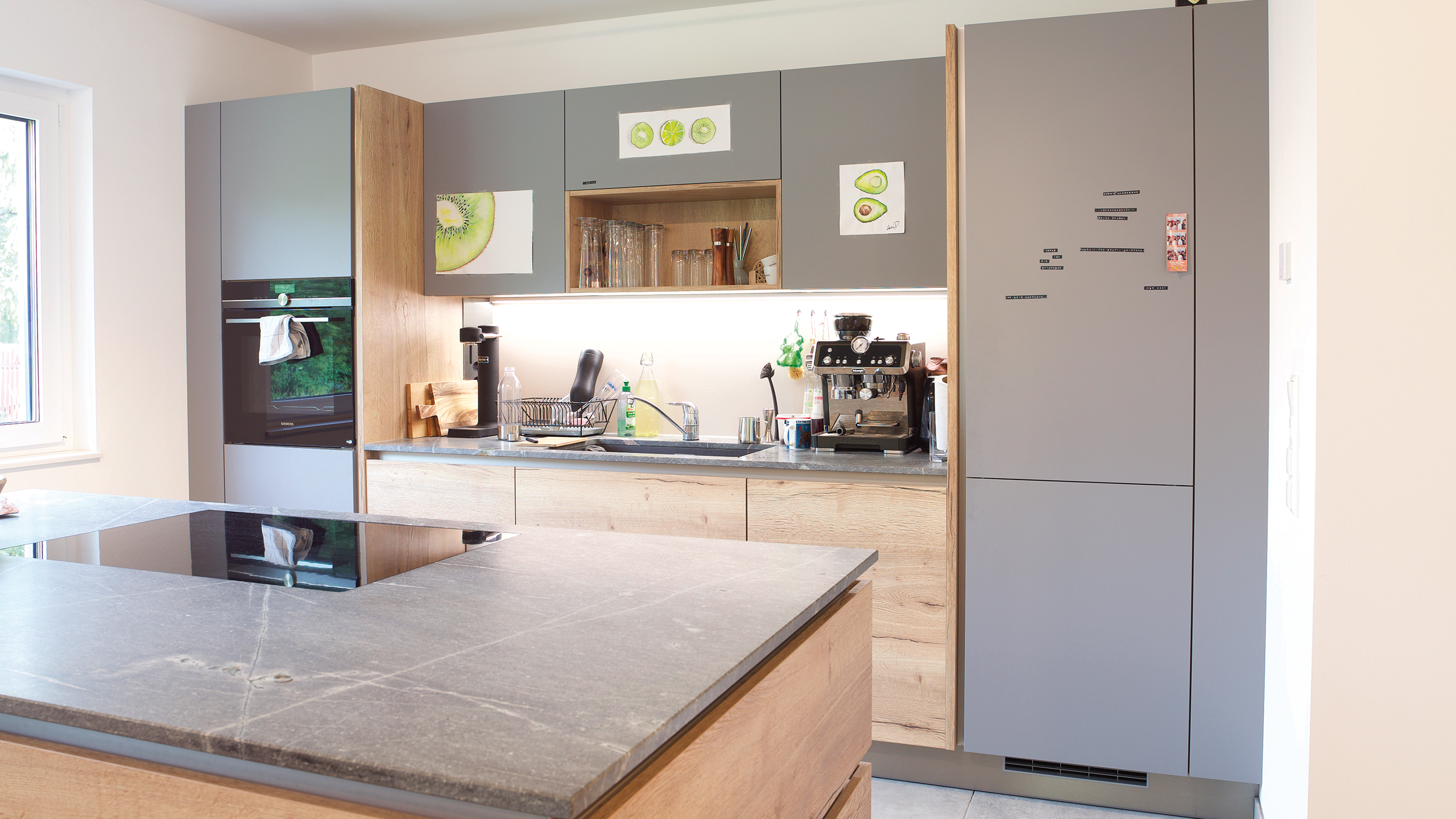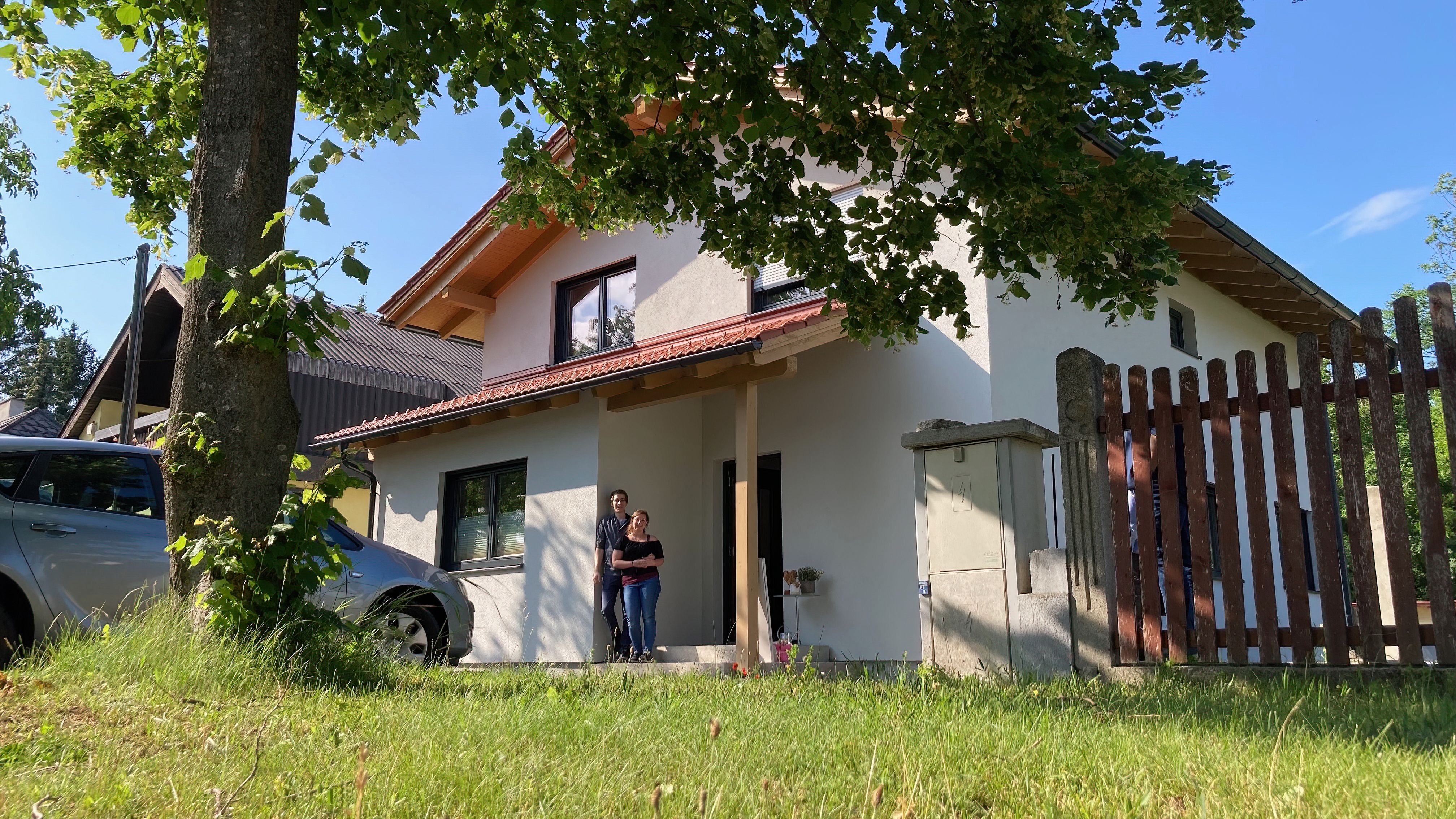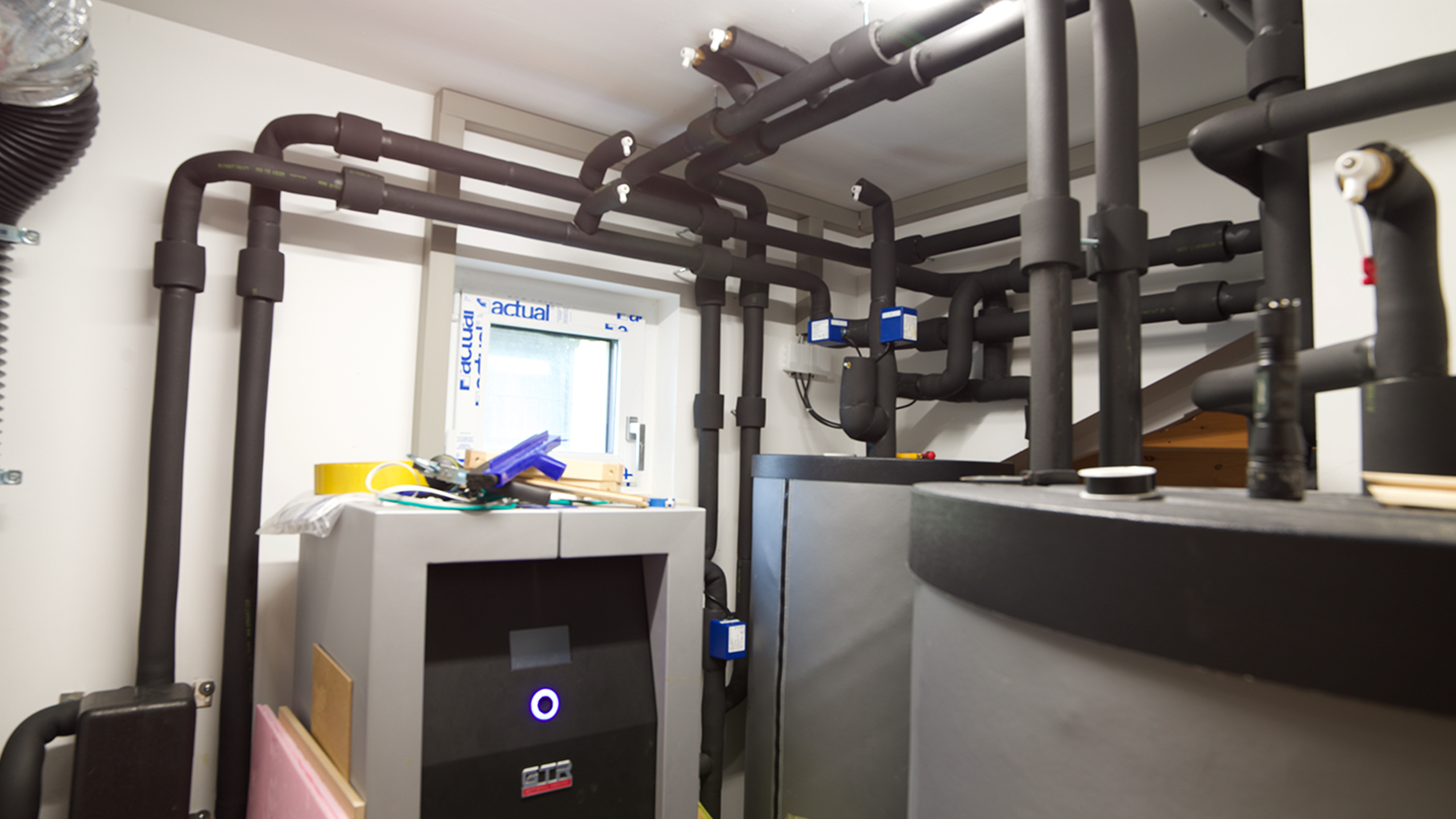Family home in the area around Baden
As soon as you enter Carina and Jonas' house, you notice something: this house has warmth. A different form of life energy. Is this due to the warm welcome, the beautiful summer day, the honey-coloured wide oak floorboards or the special features of the building itself? We asked ...
‘In this case, the warmth comes from the wooden floor. Because the heating is switched off,’ laughs Carina. However, the ceiling cooling is activated, which is only noticeable on the ceiling at second glance. The offset panel looks like an architectural design element. Completely invisible: the wall heating/cooling, with which all the exterior walls of the building are clad. But more on that later.
Carina serves coffee. From the portafilter machine. No aluminium coffee capsules. That's no coincidence either. A love of pleasure, individualism and craftsmanship are noticeable throughout the room. ‘We like to do as much as possible ourselves,’ says Jonas. ‘We are the climate change generation. You could also say: home builders 3.0.’ Away from the throwaway society. Towards sustainability. Gifted and second-hand furniture instead of mass-produced goods. Even the beautiful wooden door of the outbuilding is homemade.
Unusual for the consumer age? No. The throwaway society that established itself after the Second World War has slowly reached its peak. The sins of civilisation of the last 70 years are now coming home to roost. The challenges facing the younger generation have changed radically in the last three years. Pandemic, climate change, war in Europe. The consequences: massive price increases. Supply bottlenecks. Inflation. Exploding material costs, construction costs and energy costs. Residential areas are becoming more and more densely populated. It is becoming increasingly difficult to find free building plots to build your own home. Affordable housing is in demand - but even subsidised terraced houses are enormously expensive.
Young people in particular who want to move in together, get married and have children are confronted with this.‘I think we were very lucky that we managed it all so well beforehand,’ says Carina.Before.That was just two years ago.
‘It has become difficult to start building today. The prices of many materials are a third or even twice as expensive as they were just a few months ago. Many of our friends can no longer build. They either can't find a plot of land or the construction costs make it unaffordable. But this also brings up new aspects. Many are deciding to buy an old house and renovate it.’
The pandemic has made living in the country even more important. Working from home makes it possible. This is also reflected in rising property prices on the outskirts of cities and further afield.
Living and working has changed. ‘Vienna is a great city. But many of our friends are looking for new places to live. One of them, for example, was looking for a house share. A house with a garden in the countryside that several people share. A good solution. These are not easy times. If we hadn't been lucky enough two years ago, we would probably have renovated an old house. But the long-term costs of a thermally renovated old building are still enormous compared to a house like ours. The rent for a larger flat in Vienna costs just as much as the loan for a house in the country. And at some point it will be yours. So it pays to think long-term.’
‘Fortunately, we are also very interested in craftsmanship and have done as much as possible ourselves,’ Jonas interjects. Door frames installed, plastered, painted, everything. If you don't have this talent and have to pay for every move, it gets expensive. We do everything we can do ourselves. We watch YouTube videos and tutorials and then it's done.’
By the way, Carina planned the house entirely herself:
‘I'm 24 and work as a kindergarten teacher. Jonas is 26, a trained mechanical engineer and works as a technician. We didn't want to hire an architect. So I looked for and found an app and designed everything myself.’
The building was ultimately constructed from prefabricated timber frame elements. ‘Our house is a combination of a prefabricated house and individualism. We obtained many serious offers, looked at many houses and finally found the right provider with whom this flexibility was possible. For example, we saved ourselves the majority of the interior panelling with plasterboard and instead installed the Variotherm modular wall and ceiling panels. Everything is so seamlessly integrated that you don't even notice it in the wall thickness. The spacing between the wooden beams was set so that we could install the modular panels without any additional work. This allowed us to save 20 % of the construction costs. Instead, we relied on the advice of the Variotherm professionals and invested in extremely energy-efficient building technology.’
Due to his family connection, Jonas carries the Variotherm DNA in his blood. He grew up with a different mindset and approach to heating and cooling. As a result, he has an innate basic understanding of building technology. At least that's what we thought. ‘That's not quite true,’ Jonas objects. ‘I would simply describe myself as a practitioner. Of course I have a strong sense of sustainability. But I've entrusted the technical dimensioning of our building technology to my brother Aaron, who works at Variotherm. Knowledge of building technology is so complex and varied these days. You need experienced installers and drywall builders who really get to grips with it on a daily basis and know it really well.’
However, knowledge about house construction is now readily available thanks to installation videos and tutorials. Carina and Jonas also use this cloud intelligence: ‘Watch a YouTube clip and you're good to go. For example, we installed our doors ourselves. All you need is confidence in your own abilities. And then just do it.’
The couple decided not to build a basement. ‘In terms of costs, the basement is the most expensive room in the house due to the excavation and insulation against moisture. It doesn't pay off. And once you have it, you fill it up with stuff. The same goes for the attic,’ Jonas is convinced.
‘Our pitched roof is open at the top and activated with ceiling heating/cooling without a cavity above. Instead, we have a small outbuilding with a workshop, storage room and a small garden bar for when friends come to visit. We'd rather invite our friends into the garden for a cocktail than down into a cellar parlour.’
The decision not to have a cellar and attic is also a commitment against consumerism. ‘We don't hoard anything. What we don't need is sold and goes into the cycle of reuse. If you look around our home, there is almost nothing that we would have bought new. We took the furniture from our old flat. The wardrobe was given to us as a gift. We got the fridge second-hand. We make a clear distinction between things that only make sense to buy once. For example, the kitchen. We attach great importance to the longevity of our furnishings. And we have time and patience. Not everything has to be ready-made. That's why we do a lot of things ourselves. The combination of individual pieces contributes more to the individuality and feel-good character than a sterile interior design from a catalogue,’ says Jonas.
The living area is spacious - but not oversized. The room acoustics are pleasant. ‘The quality of life is completely different to our old flat. You'd much rather get up. You'd much rather stay at home. You simply feel more welcome. Our flat was very small and cramped, but that made it somehow cosy. In the house, we have much more space and room to breathe. It took me a little while to get used to the change. But I soon found my favourite cosy spot here too. I really enjoy the wall heating there,’ says Carina.
‘You quickly get used to this new cosiness,’ agrees Jonas. ‘You only realise how unpleasant an indoor climate can be when you're somewhere else.’ For Carina, every day in the house starts beautifully.
‘I step out of the shower onto the comfortably warm floor. When I look out of the window, I can see the little squirrels romping around. Then I always discover something new in the garden. Sometimes we even have a visit from a deer.’
‘What's really super convenient is the cooling in summer,’ says Carina. ‘In the first year, we went a bit overboard with the cooling because we were so enthusiastic about it,’ she laughs.
Building balance and energy costs
Monthly operating costs: 80 euros
Incidentally, they moved into the building site. What was finished? ‘The floor. We finished that the day before. The kitchen. The bathroom without cabinets and washbasins. The only door in the house was an old loo door. The only thing that was really finished was the building services. We moved in during the cold season and had nothing. But it was beautiful.’
The building services. A brine-to-water heat pump with two deep boreholes and a photovoltaic system have been installed. Everything is combined with Variotherm floor heating, wall heating/cooling and ceiling heating/cooling. The system runs completely autonomously throughout the year.
What will interest many young builders: How much did the house cost?
‘It doesn't make much sense to quantify the total costs in order to compare them. Depending on the plot, location and house size, it's different everywhere. But what matters is that our house is approx. 150 metres. The two deep boreholes of 70 metres each cost around 10,000 euros. As did the 6 kWp photovoltaic system. The rest of the building services, including the brine-to-water heat pump and the Variotherm complete systems, totalled around 50,000 euros.’
Compared to the total construction costs, the building services therefore have a relatively high value. However, there are also subsidies available. However, the running costs afterwards are so low that it is simply more than worth it in the long term.
Regarding the energy costs:
‘Previously, we had monthly costs of 66 euros. Due to the oil and gas crisis and the increase in electricity prices, it's now 80 euros,’ the young couple calculates.
‘Our total costs for electricity, heating and hot water therefore amount to around 960 euros for the whole year.’
